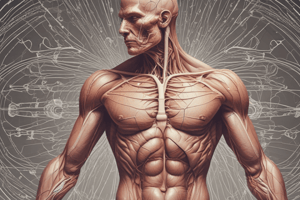Podcast
Questions and Answers
Match the following body parts with their functions:
Match the following body parts with their functions:
Arms = Allow us to manipulate objects, perform tasks, and communicate with hand gestures Legs = Support the weight of our bodies and help us walk on various surfaces Shoulders = Facilitate movement and allow the arms to move freely while supporting the weight of the upper arm when raised Ankles = Provide stability and flexibility
Match the following joint structures with their functions:
Match the following joint structures with their functions:
Elbow Joints = Flex and extend the forearm upward and downward Wrist Joints = Join the small bones of the forearm to the hand, allowing a wide range of motion Blood Vascular System = Carries nutrients, electrolytes, gases, and waste materials between different parts of the body via a complex system of vessels Lymphatic System = Aids immunity by removing bacteria, viruses, and cellular debris from tissues and returning fluid back into circulation
Match the following systems with their functions:
Match the following systems with their functions:
Skeletal System = Provides structure and protection to the soft tissues within the body, supports posture, enables movement, anchors muscles, stores calcium, and produces red and white blood cells Muscular System = Contracts to generate force and initiate movements Endocrine System = Produces, stores, and releases hormones that regulate metabolism, grow, and repair tissues, manage stress, respond to injury, and control development processes Respiratory System = Brings fresh air into the body, delivers oxygen to cells, removes carbon dioxide, and maintains homeostasis
Match the following hand components with their functions:
Match the following hand components with their functions:
Match the following circulatory system components with their functions:
Match the following circulatory system components with their functions:
Match the following bone types with their characteristics:
Match the following bone types with their characteristics:
Match the following skin functions with their descriptions:
Match the following skin functions with their descriptions:
Match the following skin layers with their descriptions:
Match the following skin layers with their descriptions:
Match the following skin roles with their functions:
Match the following skin roles with their functions:
Match the following skin characteristics with their significance:
Match the following skin characteristics with their significance:
Flashcards are hidden until you start studying
Study Notes
Parts of the Body
The human body is composed of several parts, each with its own unique functions and roles. Here's a brief overview of some of these essential components:
Head and Neck
- Brain: Responsible for thinking, reasoning, regulating heartbeat and breathing, storing memories, and controlling other organs through nerves and hormones.
- Ears: Sense sound vibrations from the air and convert them into electrical signals for the brain to interpret.
- Nose: Helps smell odors by detecting chemicals in the air; also helps warm and humidify air before it reaches the lungs.
- Mouth: Used for eating, swallowing, tasting food, speaking, and more. It contains teeth for chewing and grinding up food.
- Tongue: Tastes sweetness, sourness, saltiness, bitterness, and umami, and also allows us to speak clearly.
- Glands in the head and neck: Regulate blood pressure, control growth, produce saliva, make tears, maintain body temperature, and release hormones.
Torso
- Chest Cavity: Contains important organs such as the heart, which pumps oxygenated blood throughout the body, and the lungs, where oxygen enters our bodies during respiration.
- Abdominal Cavity: Houses vital digestive organs like the stomach, liver, gallbladder, and kidneys. These organs process food, eliminate waste products, and filter out impurities in our bloodstream.
- Back: Provides support for the spine, protects internal structures, and plays a role in movement.
- Arms: Allow us to manipulate objects, perform tasks, and communicate with hand gestures. They also house bones, muscles, tendons, ligaments, veins, arteries, lymphatic vessels, nerves, and joints necessary for their functioning.
Arms and Legs
- Shoulders: Facilitate movement and allow the arms to move freely while supporting the weight of the upper arm when raised.
- Elbow Joints: Flex and extend the forearm upward and downward.
- Hands: Composed of fingers, thumb, palm, wrist, and knuckles, they enable grasping and touching objects.
- Wrist Joints: Join the small bones of the forearm to the hand, allowing a wide range of motion.
- Ankles: Consist of two large, rounded bones attached above and below by numerous strong ligaments, providing stability and flexibility.
- Feet: Support the weight of our bodies and help us walk on various surfaces.
Other Structures
- Skeletal System: A network of interconnected bones that provides structure and protection to the soft tissues within the body, supports posture, enables movement, anchors muscles, stores calcium, and produces red and white blood cells.
- Muscular System: Contracts to generate force and initiate movements. Made up of skeletal muscle, smooth muscle, and cardiac muscle tissue.
- Blood Vascular System: Carries nutrients, electrolytes, gases, and waste materials between different parts of the body via a complex system of vessels including arteries, capillaries, and veins. Blood also transports immune cells to fight infection.
- Lymphatic System: Aids immunity by removing bacteria, viruses, and cellular debris from tissues and returning fluid back into circulation. Also houses specialized cells called lymphocytes responsible for fighting off invading organisms.
- Endocrine System: Produces, stores, and releases hormones that regulate metabolism, grow, and repair tissues, manage stress, respond to injury, and control development processes.
- Respiratory System: Brings fresh air into the body, delivers oxygen to cells, removes carbon dioxide, and maintains homeostasis. The main organs involved in this process are the nose, mouth, throat, windpipe, and lungs.
Each part of the body serves a crucial function, working together harmoniously to keep us alive and healthy. As you can see, there's much more to the human body than meets the eye!
Studying That Suits You
Use AI to generate personalized quizzes and flashcards to suit your learning preferences.



